How to Make Sourdough Starter From Scratch: Easy Step-by-Step Recipe
Have you been dreaming of fresh homemade sourdough bread, but aren’t sure where to begin? First, you need a sourdough starter! Then you can bake your own delicious gut-healthy bread, crackers, cookies, muffins and more.
Come follow our easy recipe to make a sourdough starter from scratch. This guide will show you how to transform three simple ingredients – water, flour, and apple – into an active and bubbly sourdough starter. The process takes 7 days from start-to-finish but involves very few steps or active time!
I’ve included everything you need to succeed: step-by-step photos, a video tutorial, troubleshooting tips, and resources on how to maintain and feed sourdough starter going forward. Don’t worry – it’s much easier than you think!
NOTE: This post was originally published in January 2019 and significantly updated in 2025.
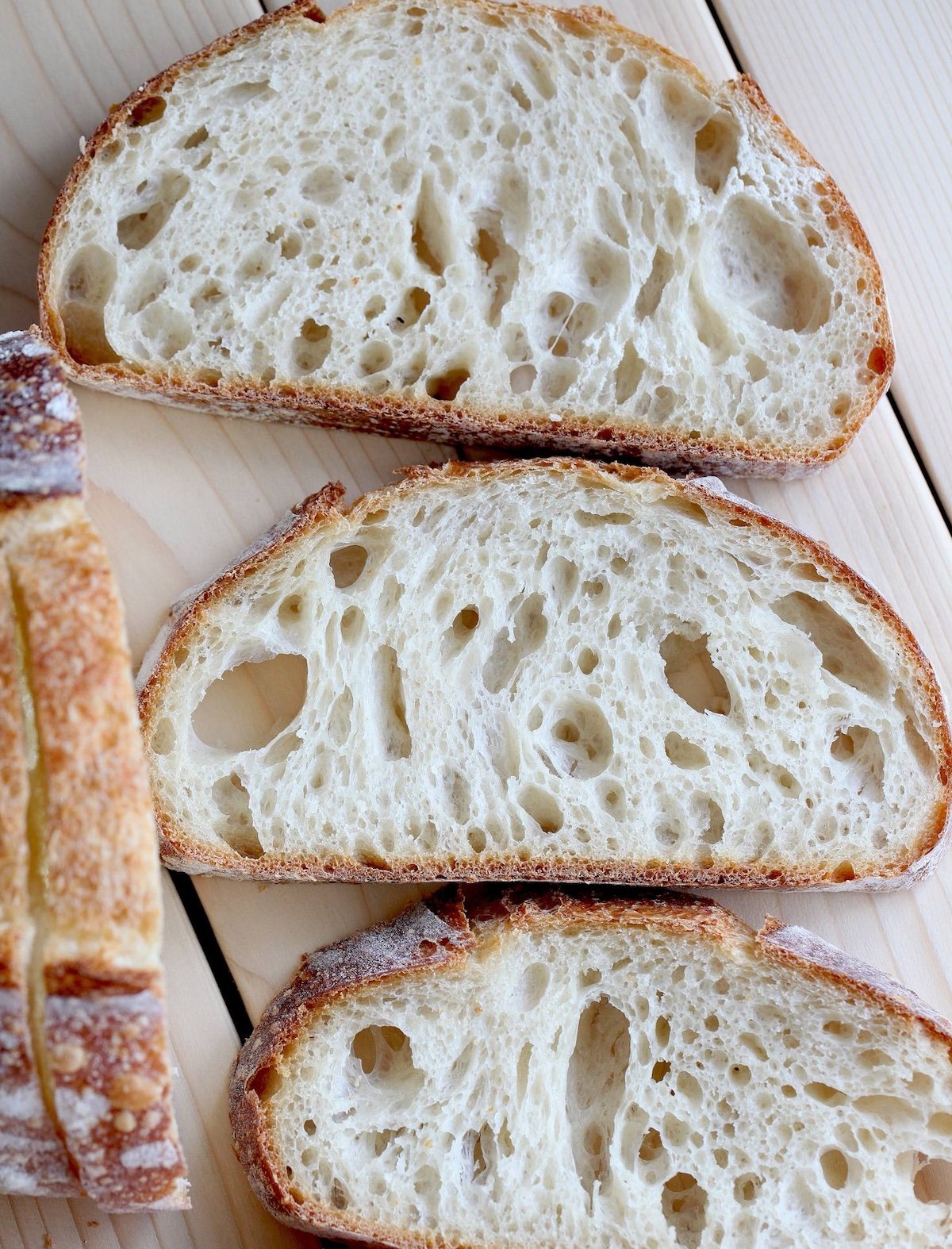
Would you like to save this?
Disclosure: Homestead and Chill is reader-supported. When you purchase through links on our site, we may earn an affiliate commission.
What Is Sourdough Starter?
Sourdough starter is a mixture of flour and water that also contains a stable colony of wild yeast and beneficial bacteria, and is nurtured by routine “feedings” to keep it alive and happy. It’s what makes bread rise without the need for commercial yeast.
If kept alive, one starter can last a lifetime of baking. And don’t worry! An established, mature sourdough starter is very easy to maintain with only infrequent feedings required (when stored in the fridge).
You can make a sourdough starter from scratch, get some from a friend who bakes sourdough, or buy one online. Since starting from scratch can sometimes be tricky, we offer organic dehydrated sourdough starter too. It’s quick, easy, and foolproof to use!
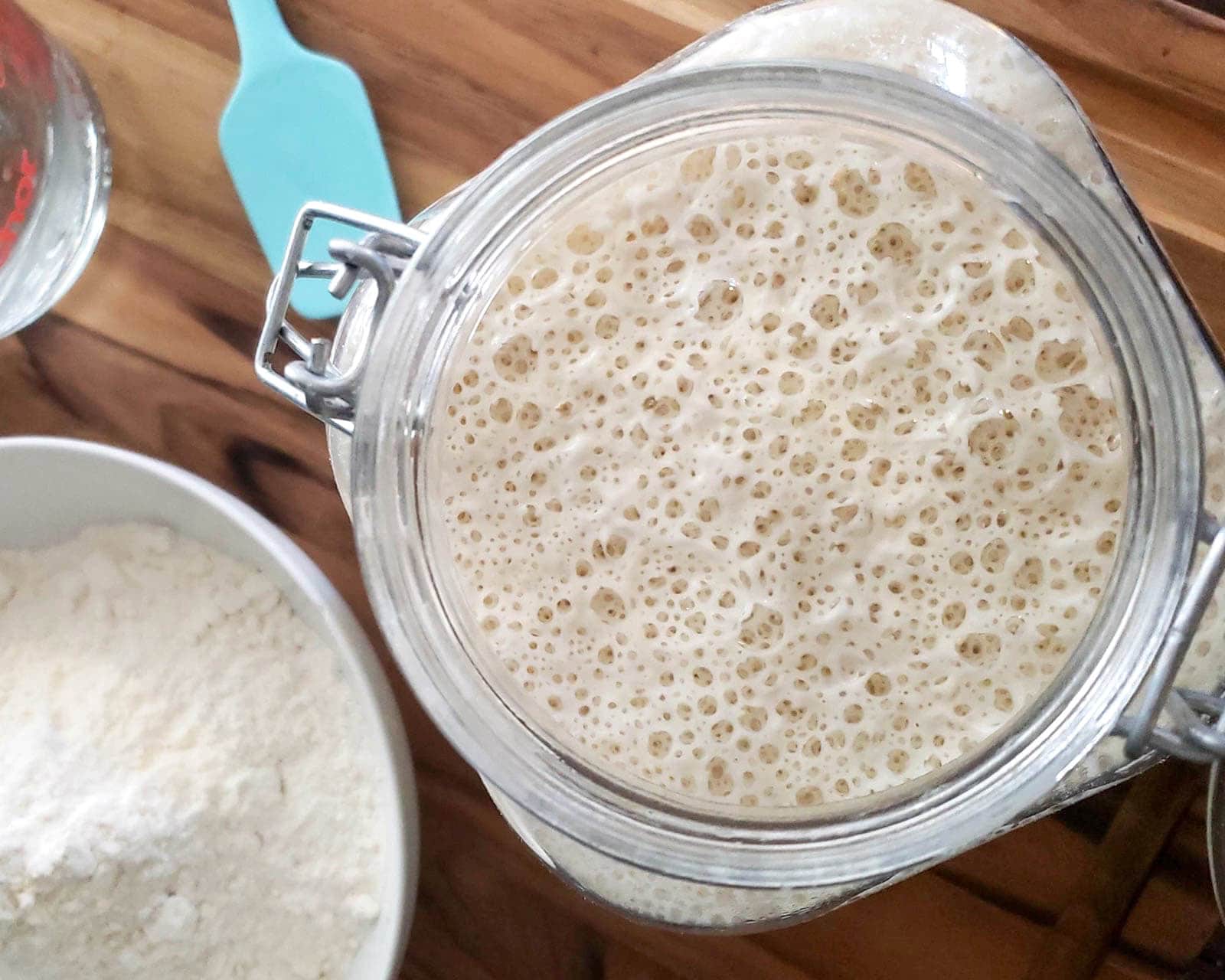
Supplies Needed
- A large, air-tight glass container. We used a 2-liter flip-top container, though a half-gallon mason jar works perfectly too.
- Organic white bread flour. You can also use organic whole wheat if you’d like.
- One large organic apple, or two small apples. See substitutions below.
- Filtered water
- A kitchen scale. Sourdough recipes are measured by weight instead of volume (cups) since different flours have varying densities or weights.
- A mixing bowl
- Liquid measuring cup
- A silicone spatula
- A cheese grater (for the apple)
- A moderately warm location
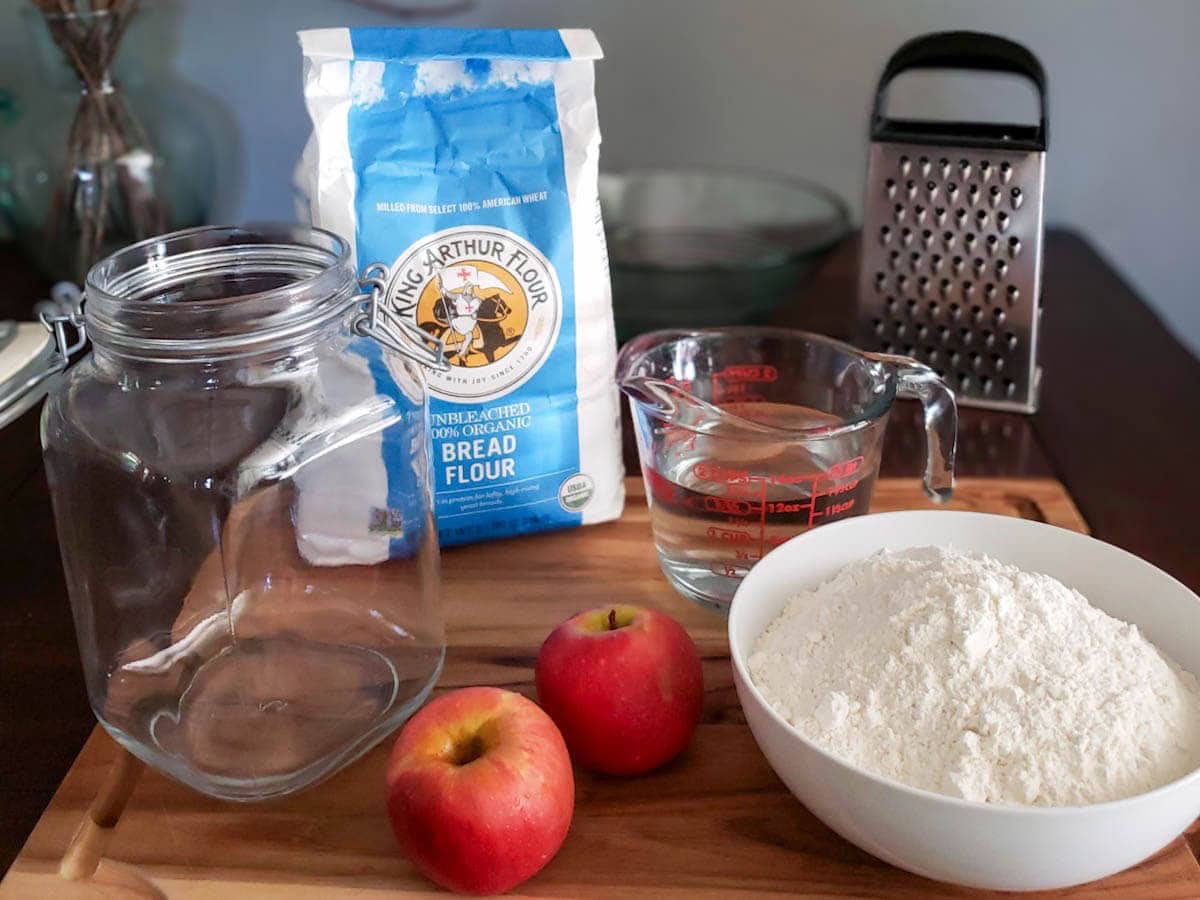
Why use apple to make sourdough starter?
Our homemade sourdough starter recipe includes apple to increase your chances of success! Flour and water alone are fairly sterile, but organic fruit and vegetables contain natural wild yeasts and beneficial bacteria on them, which helps to kick start the activity of your starter. The shredded apple completely dissolves into the starter and isn’t noticeable by day 5.
It’s key to use organic apples since non-organic produce has been treated with chemicals that can inhibit beneficial bacteria growth or contaminate your starter. If you happen to be allergic to apples, you can substitute with 1 cup of smashed organic blueberries or seedless grapes instead.
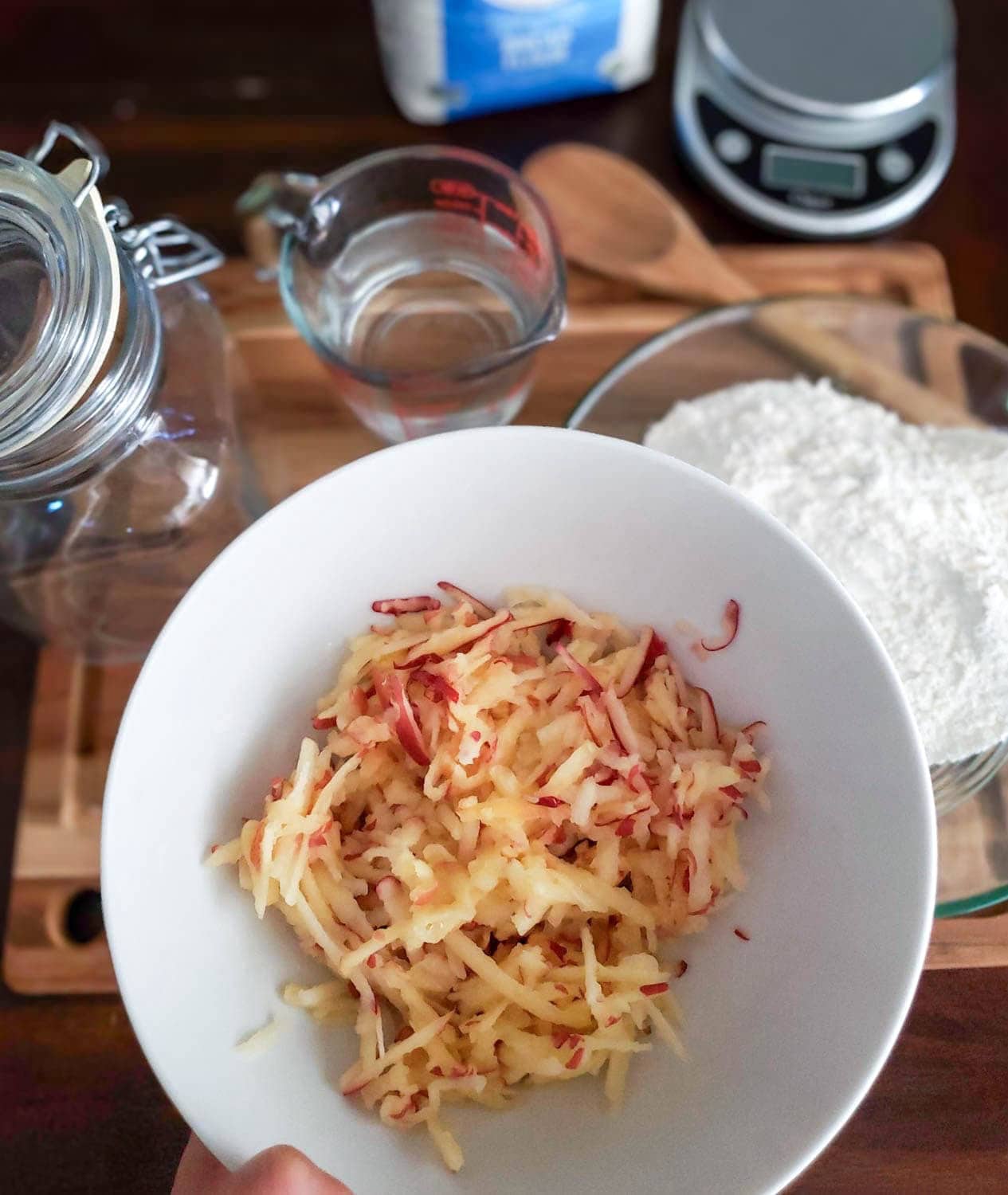
How to Make Sourdough Starter
Day 1: Mix
- In a large mixing bowl, weigh out 500 grams of organic white bread flour. Don’t forget to tare the bowl on the scale first, or add the weight of the bowl in to the total!
- Next, wash and grate the apple into fine shreds with a cheese grater. Use the peels but avoid the core, stem, and seeds. Add the apple to the bowl with the flour.
- Now add 360 mL of room temperature or warm filtered water to the bowl and mix thoroughly. It’s best to avoid chlorinated water when making sourdough if possible (but not distilled water) since chlorine can inhibit the growth of beneficial bacteria. The mixture will be quite thick and sticky at this point.
- Transfer the sourdough starter mixture into an air-tight container, pressed nicely into the bottom and with the lid closed. The container should have ample empty space to allow for the sourdough starter to at least double in size over the next few days, if not more.
- Finally, use a washable glass pen to mark the current level of the sourdough starter mixture in the container. (You could also use a large rubber band around the outside of the container.) This is to help monitor the rise!
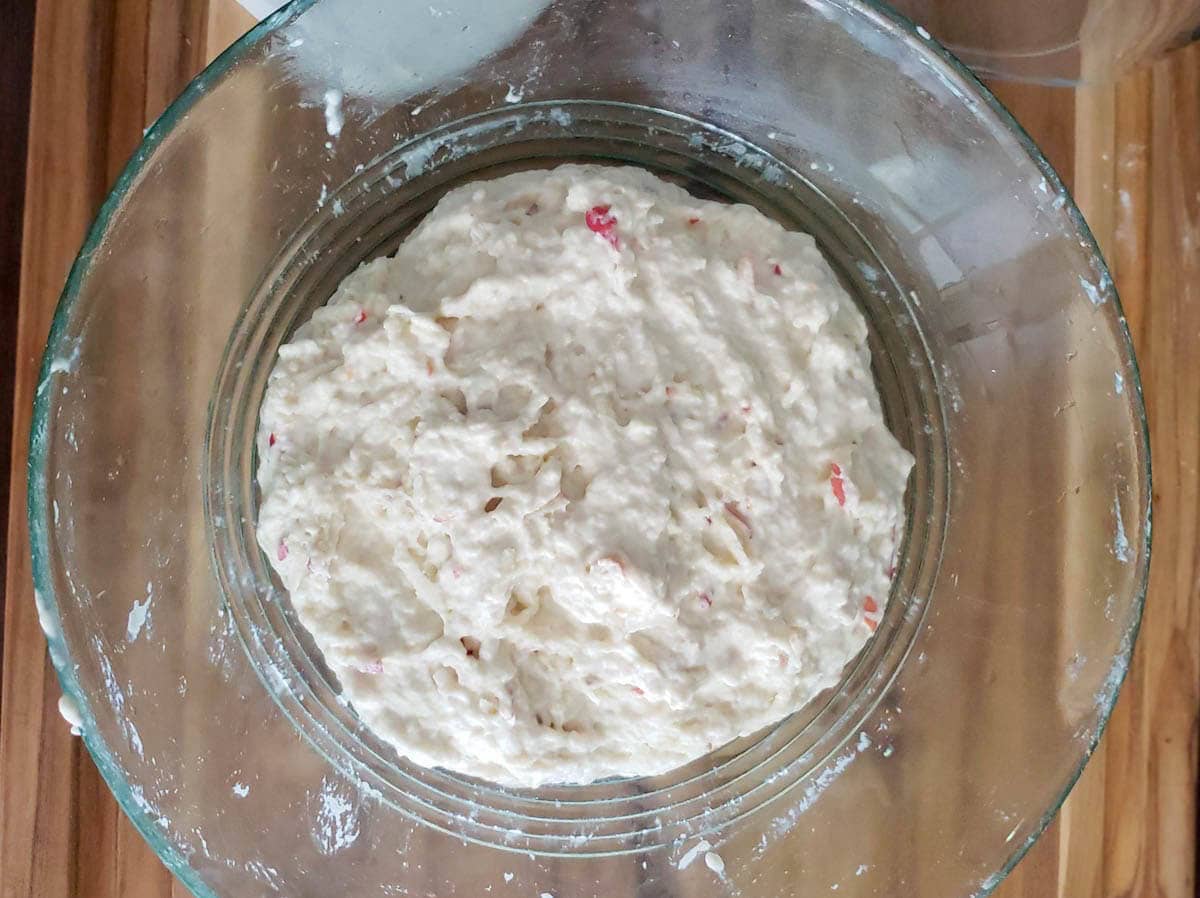
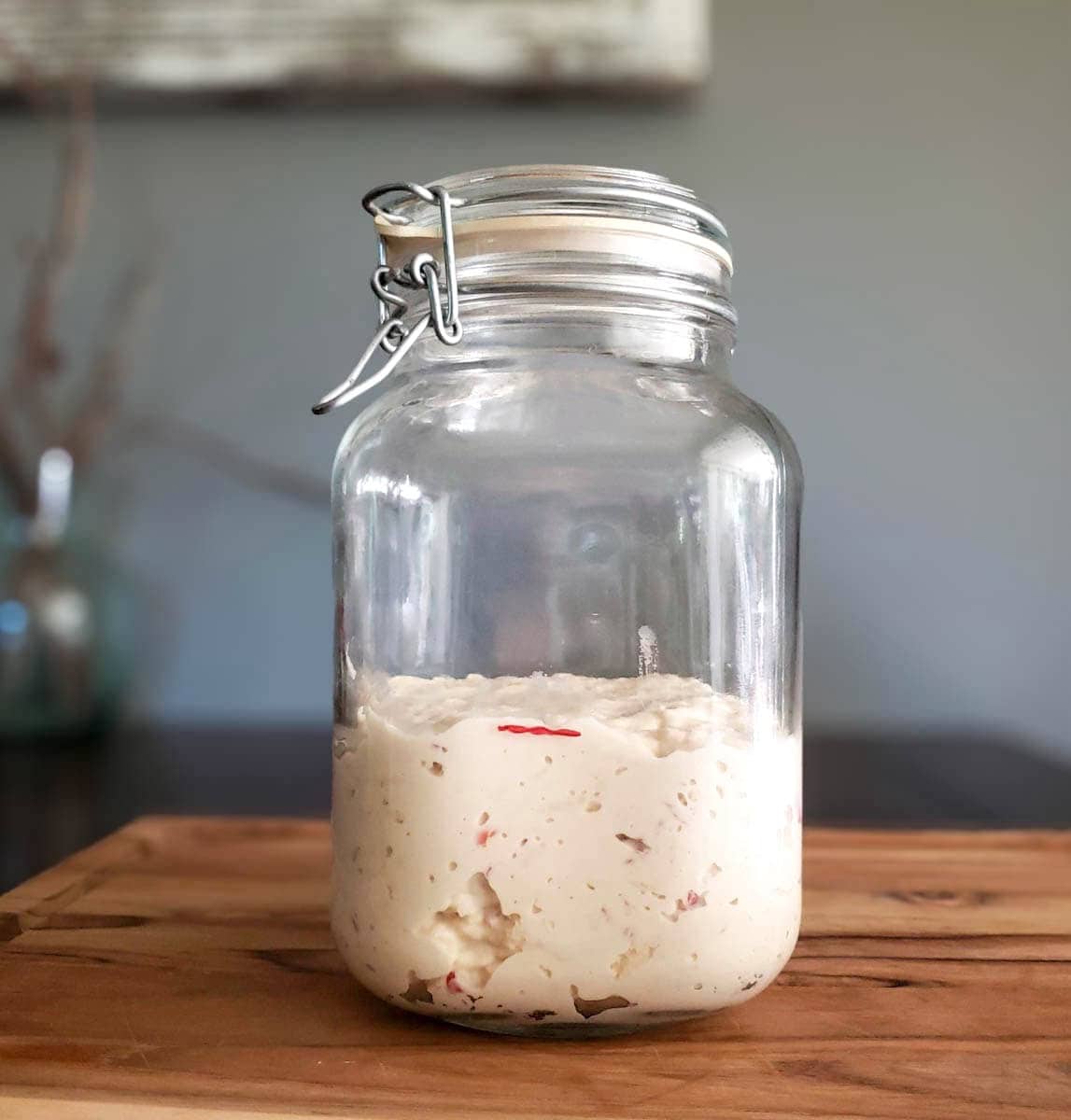
Day 2 and 3: Sit and Wait
- Now let the mixture sit for 3 days or about 72 hours after first starting.
- To make a new sourdough starter from scratch, it’s important to keep it in a location that is about 70 to 75 degrees Fahrenheit (23 degrees Celsius) to encourage beneficial bacteria activity. Cooler temperatures can easily lead to inactivity and mold growth. A dark or light location is fine, but keep it out of direct sunlight.
- If your home is cold, see tips and ideas on how to keep a sourdough starter warm below. Use a simple stick-on thermometer to easily monitor the temperature.
- During this time, the mixture may begin to form small bubbles and rise. In some cases, it may rise a lot! So you may want to keep the container on a plate to catch any overflow.
TIP: It’s possible for the sourdough starter to rise and then fall again before you notice (such as overnight) so look for smears on the sides of the container – not just the current level. However, it’s not essential to get a big rise at this stage!

Ways to keep sourdough starter warm:
- Find a warm spot in your house, such as next to or on top of a warm appliance. For example, our kitchen has under-cabinet lights that put off heat when they’re on, making the cabinets above quite warm and cozy. We’ve also placed it against a warm south-facing wall.
- Use a starter heating pad. Consider using a specialized heating pad to keep your sourdough starter warm, such as this wrap-around heat mat (thermometer included). It has precise temperature controls to keep the starter at the ideal temperature. My gardener friends use seedling heat mats too – just be sure it doesn’t get TOO hot! You may need to keep a towel or plate between the heat mat and starter jar.
- Oven light trick. Most oven light bulbs emit warmth, so turning on the oven light (but keeping the oven itself OFF) can create a nice warm spot in the back of the oven for your starter or proofing dough. However, I’ve heard horror stories when folks accidentally pre-heat or bake their starter! So if you try this, be sure to make a reminder that it’s in there – including for other members of the household.
- Proofing box. If you’re a regular baker with a chronically cool home, it may be worth investing in a proofing box – which can keep both your sourdough starter and proofing bread dough at the perfect temperature!

FAQ: What if my starter rises and falls before day 4? Can I move on to the next steps early? No, it’s best to wait. Sometimes, there is an initial burst of very vigorous activity on day 1-2, but that is usually caused by a different type of bacteria that quickly grows then dies off. Meanwhile, the main yeasts and bacteria (lactobacillus) that we want in the starter long-term grow a bit slower. So just be patient before proceeding to the next step!
Day 4: Discard and Feed
After 3 days or about 72 hours, it’s time to feed your sourdough starter for the first time! (This simply means adding fresh flour and water for it to “feed” on, so it can continue to get more active and strong.) By now, the mixture should smell sweet and tangy, sort of like apple cider vinegar. It may also be a bit darker in color.
- First, stir the mixture to knock out any air to let it fall back down to a more condensed state.
- Next, discard half of the amount in the container. This is to make more room in the jar for fresh flour, water, and to rise again! If you want to be exact, you can remove the mixture from its container, weigh it, and discard exactly half. Instead, I simply eyeball it by looking at the line marked on the jar.
- Now add 250 grams of of bread flour and 170 mL of lukewarm filtered water. Mix thoroughly. You can do this by either taking it all out of the jar, mixing it in a separate bowl, and then putting it back in – or simply mix everything right in the container itself.
- Clean up the sides of the jar a bit with a spatula so you can still monitor the rise and fall. (Also, gunky jar sides are more likely to mold.) Re-mark the level on your container if needed.
- Now, let your homemade sourdough starter sit for another 2 days or 48 hours in a warm location.
FAQ: What to do with the discard? Normally, you can use the discard from a mature sourdough starter in a variety of discard recipes like our fluffy sourdough pancakes, sourdough granola, or delicious sourdough discard crackers. However, the discard is still too young and won’t be a great addition to a recipe at this stage, so simply trash or compost it this time. Avoid putting it down your sink drain as it can cause clogs over time.
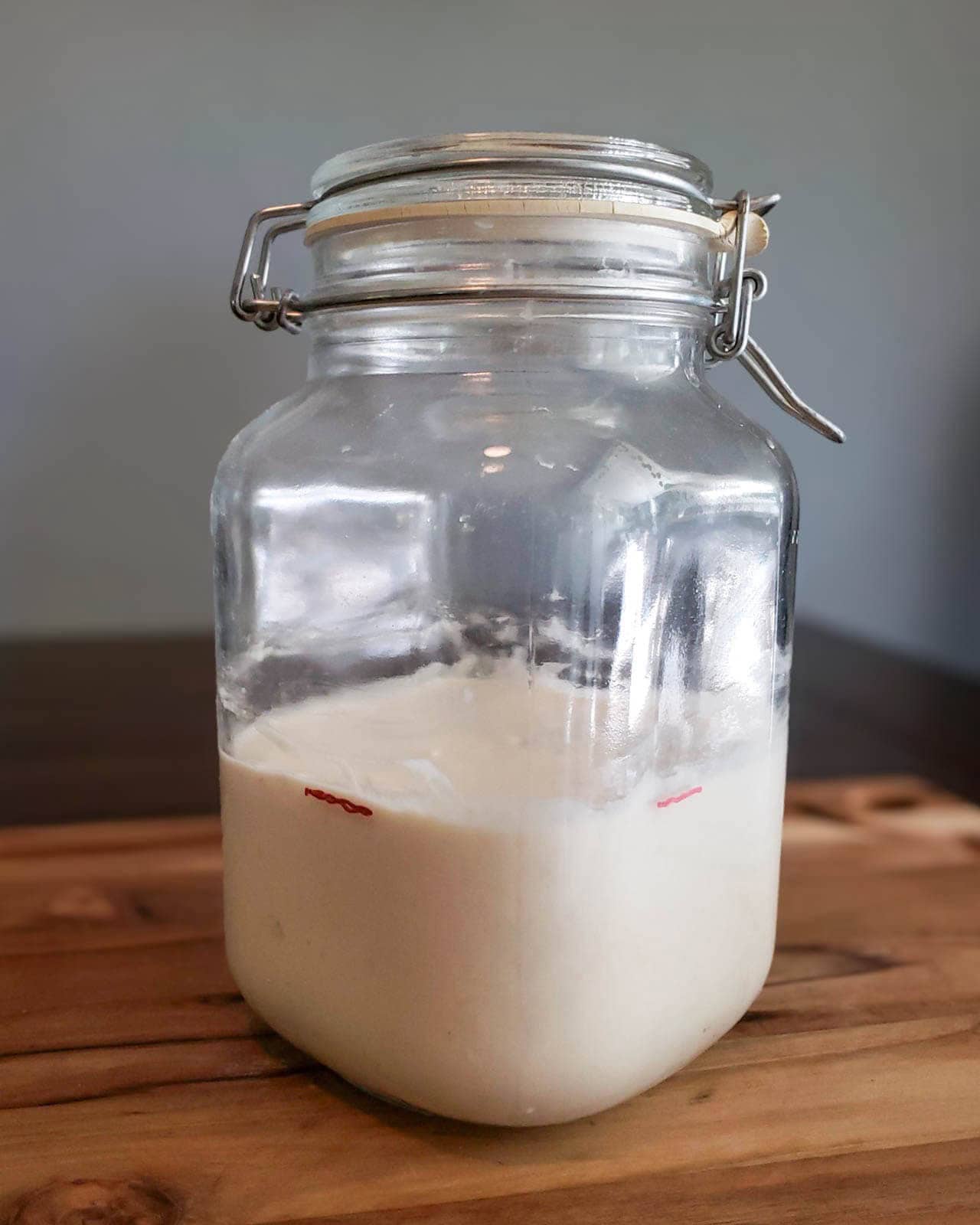
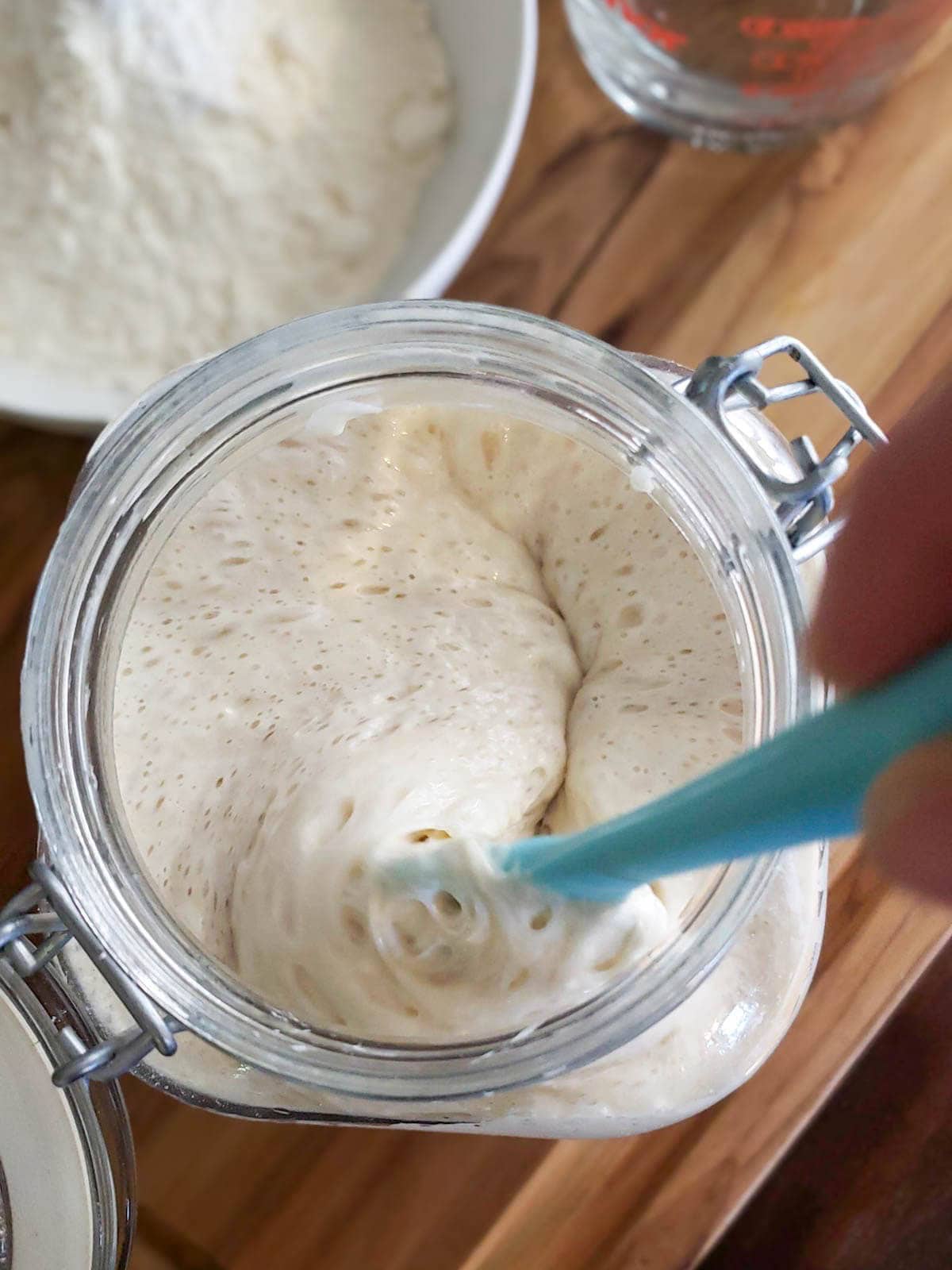
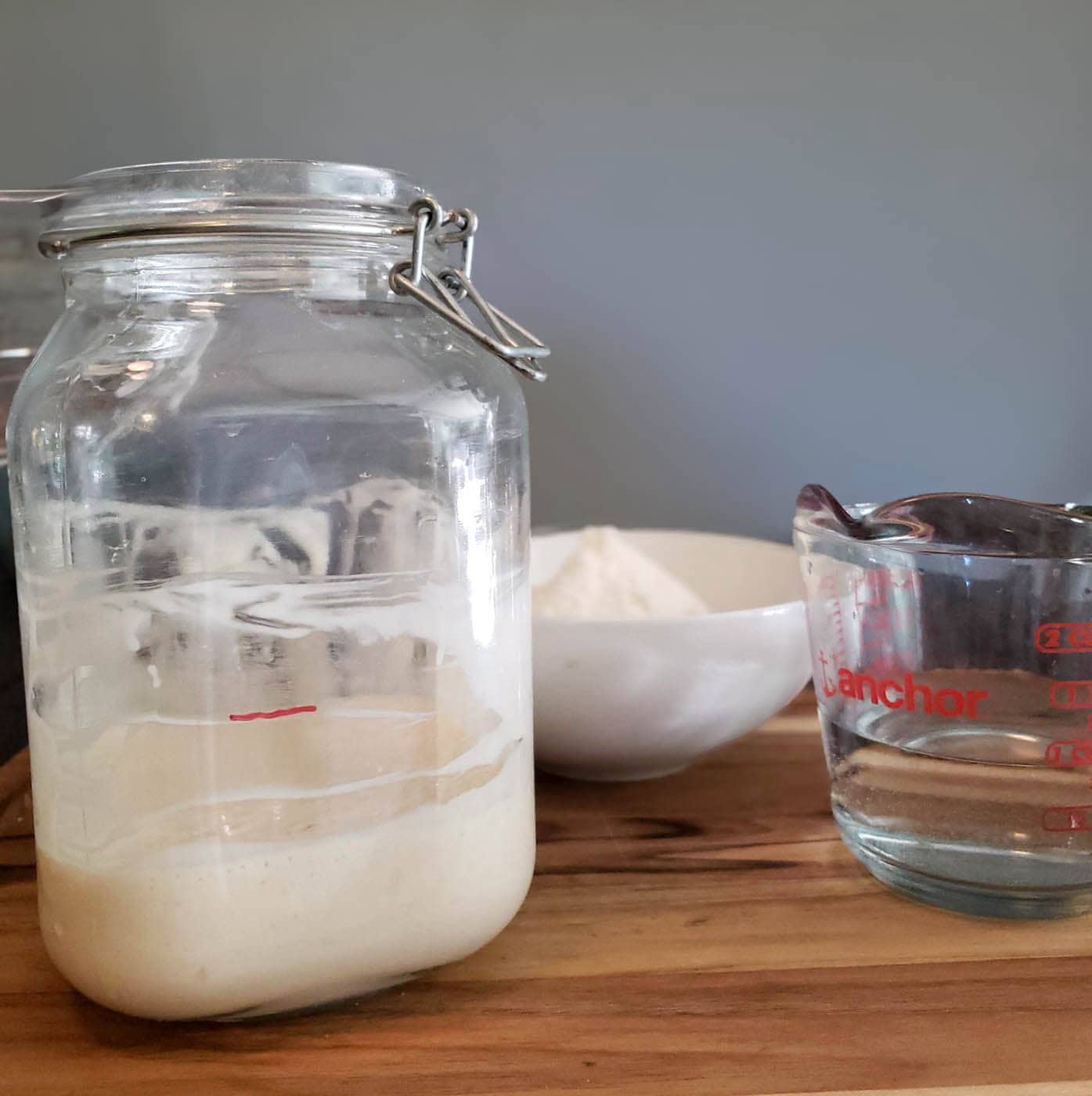

Day 5: Rest and Wait
Nothing to do today! Just let the new starter rest and rise. During this time, the colony of bacteria and yeast will happily feed on the fresh flour you provided, exponentially increasing their population as they do.
Day 6: Discard and Feed Again
Two days or about 48 hours after the first feeding, you should see a lot of activity and bubbles in your starter now! It also probably rose even higher than the first time. If so, it’s time to feed it again – just like you did on day 4.
However, if you’re not seeing much activity yet, let it sit for another day or two before discarding and feeding again. See more troubleshooting tips to increase activity below.
To feed, discard half the volume and then mix in another 250 grams flour and 170 mL of lukewarm water. It’s okay for the starter to be a tad more wet at this stage. It should be smooth and easy to stir, but not runny like pancake batter. If needed, add an extra splash of water (up to 30-40 mL more) until the desired consistency is reached.
Cover the sourdough starter and let it sit out one final time – for 24 hours this time.
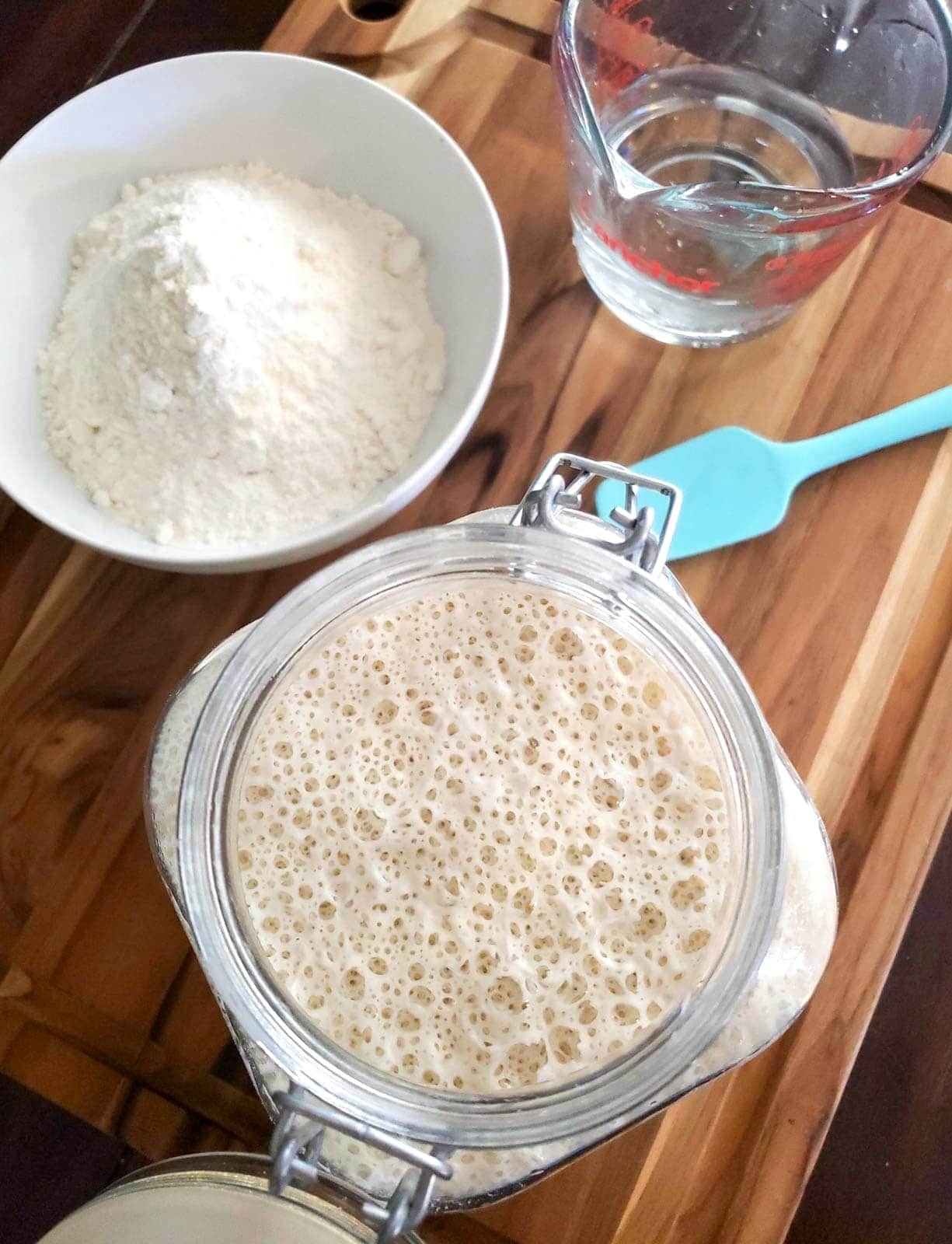
Troubleshooting
In most cases, a new sourdough starter should be bubbly and rising by day 6. However, if you are going to experience any issues, this seems to be the step where it may stall out.
- If there is no activity since the last feed, let it sit an additional day or two before feeding again.
- Is your home on the cool side? Try to find a warmer spot!
- If the starter has visible bubbles but doesn’t rise after feeding, the mixture may be too wet or runny (as varying home humidities and flour types can lead to different textures). When a starter is too wet, the bubbles rise right up and out of the mixture – rather than being trapped inside and causing the starter to puff up and become spongy. So, stir in more flour to thicken it up, adding just a few tablespoons at a time until it more closely resembles your original thick mixture from step 1 (a stiff dough).
- Another option is to try opening the lid of your jar. Cover it with a coffee filter or something else that will prevent fruit flies or other debris from getting inside.
- If your starter isn’t rising well and has a dark liquid formed on top, it may actually be overly active and hungry! Stir in a little more flour (and warm water as needed, if it becomes too thick and dry) and let it sit again. Wait a day or two to see if it perks up and begins to rise and bubble.
- Try to feed it with half whole wheat or rye flour, which usually enhances activity.
- If all else fails, it may be best to buy an established (dry) sourdough starter instead. Ours is foolproof to get going!
RELATED: Learn even more detailed troubleshooting tips in our guide on how to strengthen sourdough starter. Or, see this article on how to tell if a sourdough starter is bad.
Day 7: It’s Ready!
If it’s bubbly and active within 24 hours of the last feeding – congratulations – you just made a new sourdough starter from scratch! It’s now ready to bake with. (Keep reading below for tips on how to use and store it.)
But first, be sure to name your starter. It’s tradition among the sourdough community and considered bad baking luck if you don’t! Check out our round-up of the best 60 Punny Sourdough Starter Names for plenty of fun ideas.
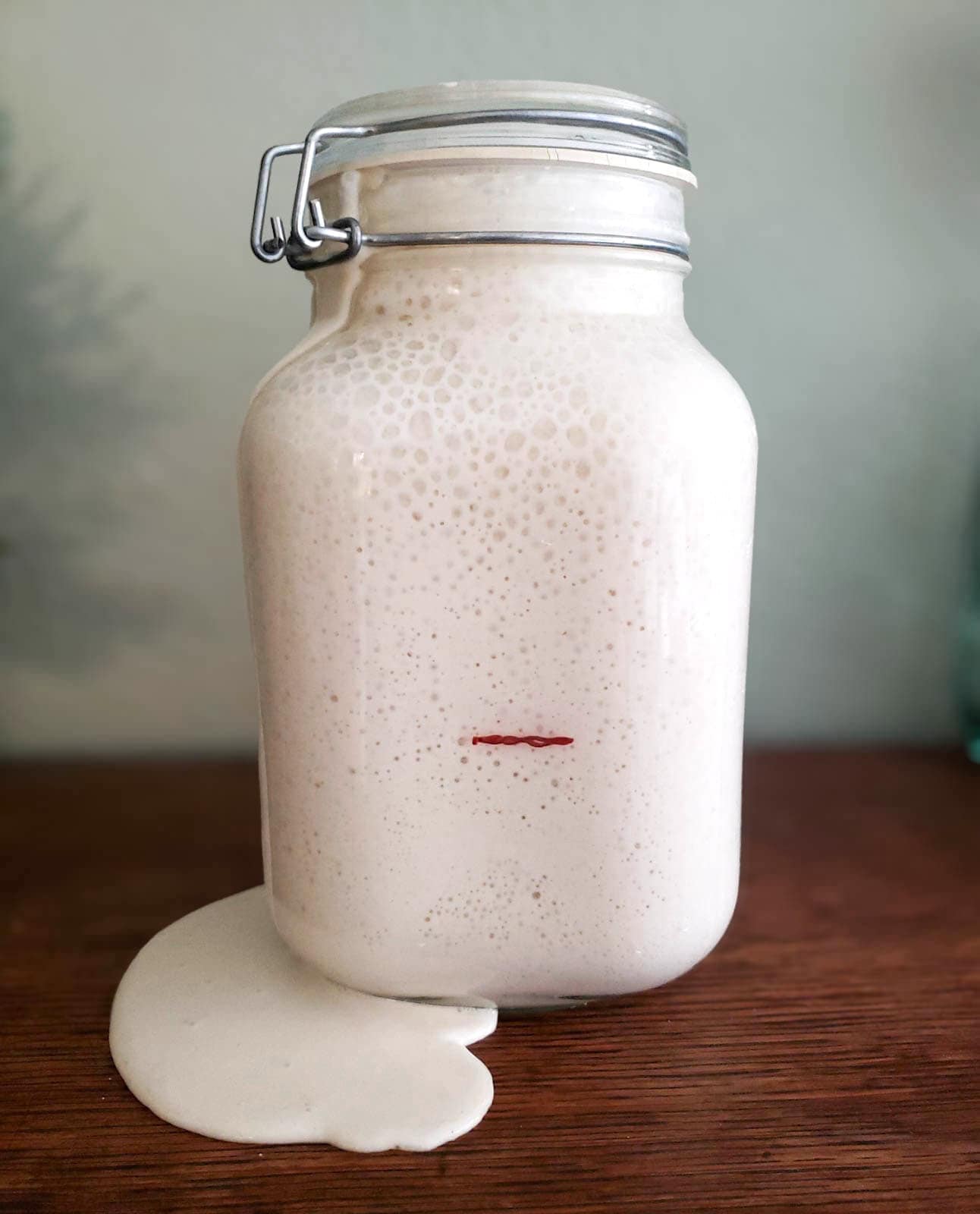
Next Steps: How to Use and Maintain Starter
Now what? If you aren’t ready to bake yet, simply store your starter in the refrigerator and then head over to our guide on how to maintain and feed sourdough starter. It covers the pros and cons of storing it at room temperature vs the refrigerator, when and how to feed it, and how to ready a starter for baking.
Hint: it’s best to use sourdough starter for baking several hours after feeding, once it’s reached “peak activity” – which is when it’s at least doubled in size, is no longer actively rising, but before it deflates again. And remember, never use ALL your starter in a recipe! Always save at least a half cup to feed and keep going.
To make bread, try our go-to no-knead sourdough bread recipe with step-by-step instructions and video. Our simple sourdough focaccia recipe is even easier! You can make all kinds of fun and delicious things like sourdough pumpkin bread, sourdough pie crust, sourdough cornbread and more! Explore all of our sourdough recipes and tutorials here.

FAQ: What’s that dark liquid on the top of my sourdough starter?
When a sourdough starter goes unfed for a while, it will form a layer of dark liquid on top called “hooch”. The yeast in starter produces hooch (an alcohol) as a natural byproduct of the fermentation process. Hooch is not harmful, but is an indication that your starter is hungry and needs to be fed.
When you see hooch, you can either pour it off the top or simply mix it back in, and then discard and feed as usual. However, mixing hooch into the starter will make it extra sour-tasting. Since we store our starter in the fridge and often go many weeks between baking/feeding, it almost always has a layer of hooch on top.
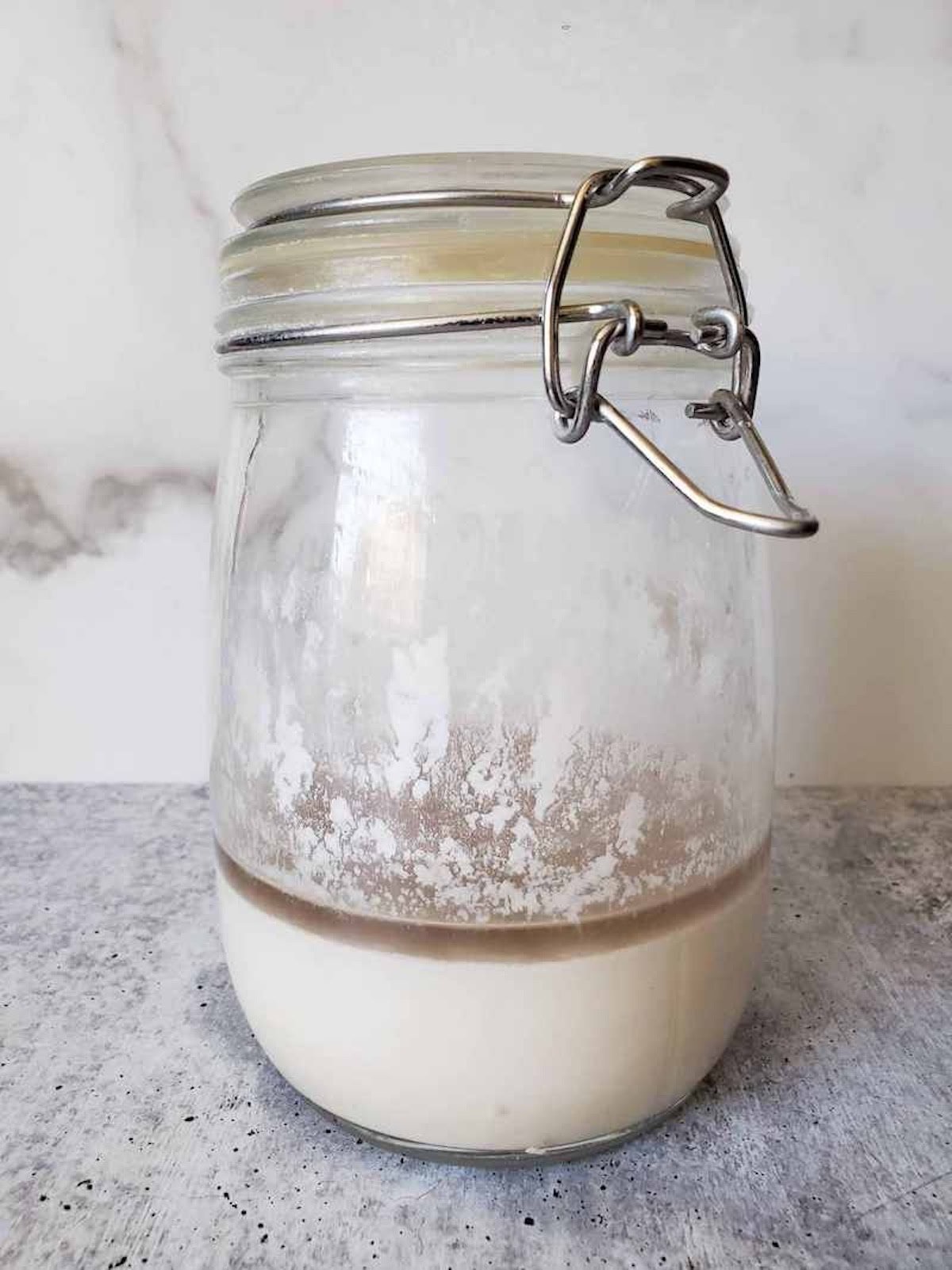
And that concludes this lesson on how to make sourdough starter from scratch. If you found this helpful, please leave a review in the printable recipe summary below! As always, feel free to ask questions in the comments below too. Have so much fun baking!
Video Tutorial

How to Make Sourdough Starter From Scratch
Equipment
- Large, glass, air-tight container (2 liter or half-gallon)
- Kitchen scale
- Mixing bowl
- Silicone spatula
Ingredients
- 500 grams organic bread flour or all-purpose flour
- 360 mL filtered water, room-temperature
- 1 large organic apple (or 2 small apples)
Instructions
- Wash your apple, but avoid using soaps or produce wash. Using a cheese grater, grate the organic apple into semi-fine shreds. Use the skins, but discard the core.
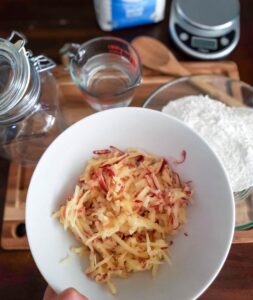
- Add the called-for flour, grated apple, and water to a mixing bowl and thoroughly combine.
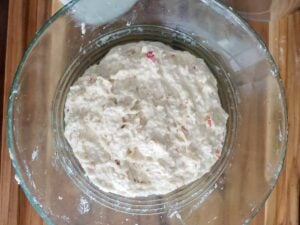
- Transfer the mixture into a large glass airtight container that has enough room for it to at least double in size, minimum. (Ours usually quadruples while fermenting) Pack the mixture down into the bottom of the container. Close the lid.
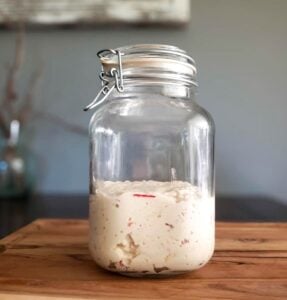
- To monitor growth, mark the side of your container with a washable marker or rubber band at the top level of the mixture.
- Let the mixture sit for 3 days at a temperature of 70-75 degrees F. It should bubble and rise during this time.
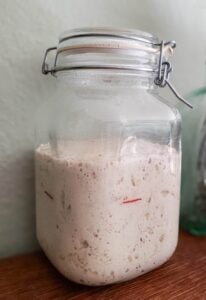
- After approximately 72 hours, thoroughly stir the mixture and then discard half of the amount. Then, thoroughly mix in another 250 grams of flour and 170 mL of tepid filtered water to the remaining starter mixture. This is called "feeding" the sourdough starter. You can do this either in a separate bowl, and put it back into a now-clean ferment vessel, or like we do, mix it in place.
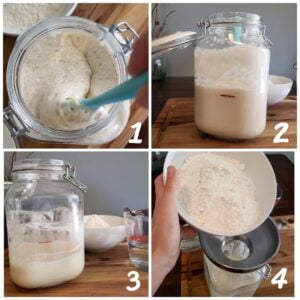
- Re-mark the container to note the height of the mixture. Let sit at 70-75 degrees, for 2 days or 48 hours this time.
- After 48 hours, repeat the same discard and feed process as done previously. Discard half, feed, mix, mark the level, and cover again.
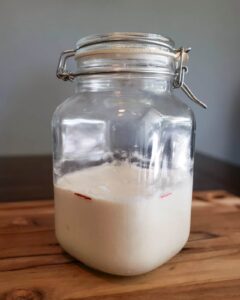
- Allow the sourdough starter mixture to sit for a final 24 hours.
- Once complete, you now have a happy and active sourdough starter! Store it in the refrigerator when not in use, giving it a discard and feed weekly. OR if stored at room temperature, feed it daily to keep it alive.
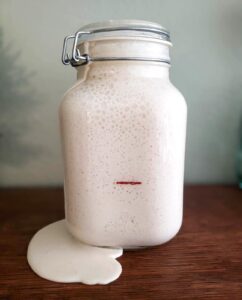
Notes
- If there is no activity, let it sit another day or two.
- If your starter has risen and fallen, or, if seems to not rise after the first discard and feed, and instead it has a dark liquid formed on top (called hooch), it may actually be overly active and hungry! Stir in a little more flour (and warm water as needed, if it becomes too thick and dry) and let it sit again. Wait a day or two to see if it perks up and begins to rise and bubble.
- If your home is cold, try to find a warmer spot if possible!
- If the starter doesn’t rise at all after the first discard and feed, try opening the lid of your jar. Cover it with a coffee filter or something else that will prevent fruit flies or other debris from getting inside inside.
- Another troubleshooting tip is to feed with half whole wheat or rye flour, which usually enhances activity.
- Ensure that you use an organic apple.








303 Comments
Louise Bennington
I’ve been trying for almost 3 weeks unfortunately. I can’t get past the first rise. Once it rises it falls then never rises again. I’ve tried adding flour, making it cooler and warmer, using less water, using half whole wheat flour to make, using only whole wheat flour to feed, using only bread flour to feed, using only bread flour to make, I tried using organic wild blueberries instead of apple even. Everything is organic. No matter what I do, I can’t get past first rise … 🙁 any other tips?
Aaron (Mr. DeannaCat)
Hi Louise, that sounds frustrating and I am sorry you are having difficulty getting the starter going. We have heard from some people in the past that they had similar issues and we couldn’t figure out what exactly the problem was. That is one of the reasons we starter making Dehydrated Organic Sourdough Starter (Dry but Alive!) for people to purchase, it is a fairly easy and straight forward way to creating your own starter in less time and ingredients. Let us know if we can help out in any other way. Good luck!
Louise Bennington
It finally worked!! Took FOREVER for some reason but I’m glad I just kept feeding it. I used your guys recipe for simple sourdough bread and it came out awesome! So excited to try again. Any tips for making the loaf less dense? It was still good but every time I bake bread it comes out a bit dense so it must be something I’m personally doing wrong lol
Aaron (Mr. DeannaCat)
Hi Louise, glad you were finally able to make your own sourdough starter and baked your first loaf. Are you baking in a dutch oven or combo cooker? We find that preheating our bakeware for close to an hour before placing the loaf in the hot bake pan for baking helps with “oven spring”, also keeping your dough in 70-75 degrees F (during the stretch and fold and bulk fermentation phase) before you cold proof it overnight helps keep the dough active and fluffy. It just takes a little experimentation to get it right, our first loaf didn’t look anything like the loaves we now bake either. Hope that helps and good luck!
Marcey
Hello,
Do you always need to discard before feeding? I want to Bake 2 loaves of bread and not too sure about the measurements to feed, etc.
Thanks,
Marcey
Aaron (Mr. DeannaCat)
Hi Marcey, it is best to discard before you feed because it allows for that much more activity in your starter. If your starter is in a quart or liter sized jar like ours, we would discard the starter so there is an inch or two left in the bottom of the jar and feed it a scant cup flour and a half cup water (you may add a little more water if it is too thick). Once you reach peak activity, I think there will be enough starter for you to use for two loaves while also leaving enough behind in the jar for the next time you bake. Hope that helps and good luck!
Marcey
Hello!
By about a day and a half to two days my starter erupted and spilled all over. I did have a plate under it to keep my over clean. I had it in a large mason jar. It then fell and when I looked at it at the end of day two, it is now just about 3/4 ” above my line. Today is Day 3 and need to discard. My question is should I have done that on Day 2 as it was so active or was it suppose to do that?
Any thoughts would be appreciated!
Thanks,
Marcey
Aaron (Mr. DeannaCat)
Hello Marcey, sounds like you’re creating a very active starter. It is fine waiting till the third day as there will likely still be beneficial bacteria within your starter that will still be present during your next discard and feed. Good luck and let us know how it turns out for you!
Kety
Hi Deanna and Aaron!
My sourdough starter is at Day 7. I can see some bubbles, but , it is not runny, it doesn’t have any liquid on the top and it is sitting on 25C. It’s not moldy and it tastes sour. My problem is that it is not rising at all. So my question is – what do I do with it now? Do I discard and feed or I wait another day, just observing?
I have another question – can I leave the discard in the fridge for some time? I want to use it to make some crackers, but I don’t have the time right now. How much time is it safe to stay in the fridge?
Thank you for your help!
Aaron (Mr. DeannaCat)
Hello Kety, your starter doesn’t necessarily need to have a layer of liquid on top, that is typically referred to as ‘hooch” which occurs when your starter is hungry and needs to be fed. If it smells and tastes sour, that is a good thing because it shows that there is some activity in there. You may have to adjust the ratio of flour and water to make the starter a better consistency, kind of like thick pancake batter. If your starter is in a one liter container, I would discard an amount of starter so there is about 2 inches of starter left in the jar. From there, feed the starter about 1 cup of flour and 1/2 cup water. Slightly adjust your amounts to reach the right consistency and leave the starter around 75 degrees Fahrenheit as you have been. It should rise within a span of 4 hours or so. If your discard is sour enough you can leave it in your refrigerator for a week or two without any problems. We store our sourdough starter in the refrigerator and take it out about every two weeks to feed it and use for baking. Hope that helps and good luck!
Chrissy
I’m so confused by the texture of my starter at first step versus your pictures. What is the consistency of the mix at its first step supposed to be? Yours seems pretty wet but mine is fairly dry even though I accidentally added too much water. Thanks!
Aaron (Mr. DeannaCat)
Hello Chrissy, it should almost look like oatmeal as it is much thicker than the starter will actually be once the process is completely finished. You may just have to “eyeball” it, if it’s dry just add a little more water until a better consistency is reached. Usually there is some room for adjustments so just go with what seems right and you should be able to get the soon to be starter active. Good luck!
Dessaray Greminger
Hi Deanna and Aaron!
I’m on day 3 of my sourdough starter, Little Yeasty hehe, with tomorrow being the first feed and discard day.. but this morning I saw mold 🙁 obviously I should start over? Where did I go wrong? Is it possible it got too warm? Temps have been swinging from 60 to 85 in our house this week.
I know you two are busy with the move right now, so no rush on a response!!
Xoxo,
Dessaray
Aaron (Mr. DeannaCat)
Hi Dessaray, sorry for the delayed response. Hopefully you got the mold issue remedied? It seems like your temperatures were good so I am not sure why it started to mold? Let us know how it worked out for you or if you were able to start over with success. Hope all is well and good luck!
Heather
Hello!
I created my starter, and it rose to the top of the jar and began to fall after only 24 hours. It already swells like sweet apple cider vinegar. Should I still leave it to sit for 72 hours, or should I begin step #2 because it has fallen and is hungry?
Thanks! 🙂
Aaron (Mr. DeannaCat)
Hello Heather, I would let it sit for one more day to give the bacteria and yeast more time to populate. However, you can probably start a day early after only 48 hours. Good luck!
Jill
Great post! I made my first starter last night, before I found your site. I cut up 5 organic grapes pretty finely and added to my flour and water. It’s almost doubled in size already…seems to be slowing down now though. Whew! Question….do I need to somehow strain out the pieces of grapes at some point? The recipe I am following does not mention it, and your recipe does not mention removing your apple shreds.
Thank you very much….will be following your direction from here on!
DeannaCat
Hi Jill – Way to be creative in using grapes! No, the grapes (or apples) will simply dissolve into the starter. You won’t even be able to tell they were there by the end of the process. Enjoy!
TERESA ROBINSON
Hi! This is my first sourdough starter recipe I’ve tried, how is it supposed to smell? Just wanted to be sure what I’m smelling is normal.
Thank you,
Teresa
Aaron (Mr. DeannaCat)
Hello Teresa, it should smell tangy and slightly sweet, almost like ACV, yogurt, or yeasty beer smell. Just stick to it and see what you come up with. Good luck!
Aaron (Mr. DeannaCat)
Hello Jill, we have a local bakery here that first started their sourdough starter with blueberries! You don’t need to do anything with the fruit because it will soon disappear into your starter and will become unnoticeable. Congratulations on your new starter and happy baking!
Shellbe Cucuel
Hi! I just baked my first ever loaf of sourdough and I am ridiculously excited! I followed your directions exactly and it turned out amazing! Thank you so much for giving such great direction. I have made so many recipes and projects from your blog and everything has turned out great 🙂 I have enjoyed your Spotify playlists too! Finding this blog has made this quarantine life a lot more interesting! Lol
Love & Light,
Shellbe
Kristina Udd
My starter was great until after the second discard and feed. It’s only risen about an inch in two days. I don’t know if I should discard and feed or just continue to wait and let it develop to see what it will do. It is full of bubbles, just not rising much. It’s in a warm spot and I’m using whole wheat flour. Any advise?
Aaron (Mr. DeannaCat)
Hello Kristina, try stirring in a 1/2 cup of flour and see if that helps. Sourdough starters that are more wet usually don’t rise as much because the air bubbles escape out and aren’t trapped inside like starters that are thicker in consistency. As long as it isn’t molding you still have a chance to make it work. Hope that helps and good luck!
Renae Mattson
Hello,
First of all, I’m so grateful to have discovered you on Instagram! My son and I have started to raise monarch caterpillars after being inspired by your work 😊
Second, and the real reason I’m in this thread, I’ve used your recipe twice to begin a sourdough starter. Both times, it doubled in size within 24 hours and then collapsed within the next few hours.
My question is, do we need the full 72 hours to mature a new sourdough starter, or should I move to the feeding stage after this initial 24 hour rise? I threw out my first attempt out of panic, but having it happen a second time, I wonder if I’m just overthinking this.
Thanks so much for sharing your expertise on so many homestead topics. I am in the process of setting up an indoor seedling unit 😊
Best, Renae
Aaron (Mr. DeannaCat)
Hello Renae, so glad to hear you and your son have found something you enjoy together. Yes, you need the full 72 hours to start the process of creating a healthy and active sourdough starter from scratch. It is fine if the mixture rises and falls, it is still active, just follow the timeline as close as possible and you should have a healthy and active sourdoughs starter within one week. Hope that helps and good luck, thank you for being a member of the community!
Kjersti Etue
Just started mine yesterday and it looks perfect! In fact, it has doubled in size in 28 hours. I’m worried it will continue growing and spill out of my 2 liter jar before I hit the 72 hours. What should I do? Thanks!
Aaron (Mr. DeannaCat)
Hello Kjersti, you may have to transfer the mixture into a larger jar if it starts to overflow or just wait it out and see what happens. Good luck with your newly made starter!